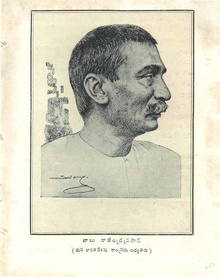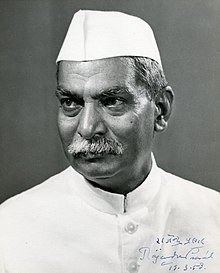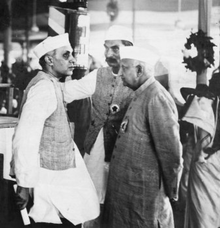DR. RAJENDRA PRASAD
Dr. Rajendra Prasad (3 December 1884 – 28 February 1963) was the first President of India, in office from 1950 to 1962.[1] He was an Indian political leader, and lawyer by training, Prasad joined the Indian National Congress during the Indian Independence Movementand became a major leader from the region of Bihar. A supporter of Mahatma Gandhi, Prasad was imprisoned by British authorities during the Salt Satyagraha of 1931 and the Quit India movement of 1942. After the 1946 elections, Prasad served as Minister of Food and Agriculture in the central government. Upon independence in 1947, Prasad was elected as President of the Constituent Assembly of India, which prepared the Constitution of India and served as its provisional parliament.
When India became a Republic in 1950, Prasad was elected its first President by the Constituent Assembly. Following the general election of 1951, he was elected President by the electoral college of the first Parliament of India and its state legislatures. As President, Prasad established a tradition of non-partisanship and independence for the office-bearer, and retired from Congress party politics. Although a ceremonial head of state, Prasad encouraged the development of education in India and advised the Nehru government on several occasions. In 1957, Prasad was re-elected to the presidency, becoming the only president to serve two full terms.[2
Parentage
Rajendra Prasad[3] was a Kayastha Hindu[4] and born in Zeradai, in the Siwan district of Bihar. His father, Mahadev Sahai, was a scholar of both the Sanskrit and the Persian languages, while his mother, Kamleshwari Devi, was a religious woman who would tell stories from the Ramayana to her son, Prasad.
Student life
When Prasad was five years old, his parents placed him under the tutelage of a Moulavi, an accomplished Muslim scholar, to learn the Persian language, Hindiand arithmetic. After the completion of traditional elementary education, he was sent to the Chapra District School. Meanwhile, in June 1896, at an early age of 12, he was married to Rajavanshi Devi. He, along with his elder brother Mahendra Prasad, then went to study at T.K. Ghosh's Academy in Patna for a period of two years. He secured first in the entrance examination to the University of Calcutta and was awarded Rs. 30 per month as a scholarship.
Prasad joined the Presidency College, Calcutta in 1902, initially as a science student. He passed the F. A. under the University of Calcutta in March 1904 and then graduated with first division from there in March 1905.[5] Impressed by his intellect, an examiner once commented on his answer sheet that "examinee is better than examiner".[6] Later he decided to focus on the study of arts and did his M.A. in Economics with first division from the University of Calcutta in December 1907. There he lived with his brother in the Eden Hindu Hostel. A devoted student as well as a public activist, he was an active member of The Dawn Society.[7] It was due to his sense of duty towards his family and education that he refused to join Servants of India Society. Prasad was instrumental in the formation of the Bihari Students Conference in 1906 in the hall of the Patna College. It was the first organization of its kind in India and produced[8]important leaders from Bihar like Anugrah Narayan Sinha and Krishna Singh, who played a prominent role in the Champaran Movement and Non-cooperation Movement.
Career
As a teacher

(Sitting L to R) Prasad and Anugrah Narayan Sinha during Mahatma Gandhi's 1917 Champaran Satyagraha
Rajendra Prasad served in various educational institutions as a teacher. After completing his M.A in economics, he became a professor of English at the Langat Singh College of Muzaffarpur in (Bihar) and went on to become the principal. However, later on he left the college for his legal studies and entered into the Ripon College, Calcutta (Presently Surendranath Law College). In 1909, while pursuing his law studies in Kolkata he also worked as Professor of Economics at Calcutta City College. In 1915, Prasad appeared in the examination of Masters in Law, passed the examination and won a gold medal. He completed his Doctorate in Law from Allahabad University in 1937.[9]
As a lawyer
In the year 1916, he joined the High Court of Bihar and Odisha. Later in the year 1917, he was appointed as one of the first members of the Senate and Syndicate of the Patna University. He also used to practice law at Bhagalpur, the famous silk-town of Bihar.
Role in the Independence Movement
Prasad's first association with Indian National Congress was during 1906 annual session organised in Calcutta, where he participated as a volunteer, while studying in Calcutta. Formally, he joined the Indian National Congress in the year 1911, when the annual session was again held in Calcutta. During the Lucknow Session of Indian National Congress held in 1916, he met Mahatma Gandhi. During one of the fact-finding missions at Champaran, Mahatma Gandhiasked him to come with his volunteers. He was so greatly moved by the dedication, courage, and conviction of Mahatma Gandhi that as soon as the motion of Non-Cooperation was passed by Indian National Congress in 1920, he retired his lucrative career of lawyer as well as his duties in the university to aid the movement.
He also responded to the call by Gandhi to boycott Western educational establishments by asking his son, Mrityunjaya Prasad, to drop out of his studies and enrol himself in Bihar Vidyapeeth, an institution he along with his colleagues founded on the traditional Indian model.[10]
During the course of the independent movement, he interacted with Rahul Sankrityayan, a writer, and polymath. Rahul Sankrityayan was greatly influenced by Prasad's intellectual prowers, finding him to be a guide and guru. In many of his articles he mentioned about his meeting with Sankrityayan and narrated about his meetings with Sankrityayan. He wrote articles for the revolutionary publications Searchlightand the Desh and collected funds for these papers. He toured widely, explaining, lecturing, and exhorting the principles of the independence movement.[citation needed]
He took an active role in helping the affected people during the 1914 floods that struck Bihar and Bengal. When an earthquake affected Bihar on 15 January 1934, Prasad was in jail. During that period, he passed on the relief work to his close colleague Anugrah Narayan Sinha.[11] He was released two days later and set up Bihar Central Relief Committee on 17 January 1934, and took the task of raising funds to help the people himself. During 31 May 1935 Quettaearthquake, when he was forbidden to leave the country due to government's order he set up Quetta Central Relief Committee in Sindh and Punjab under his own presidency.
He was elected as the President of the Indian National Congress during the Bombay session in October 1934. He again became the president when Netaji Subhash Chandra Bose resigned in 1939. On 8 August 1942, Congress passed the Quit India Resolution in Bombay which led to the arrest of many Indian leaders. He was arrested from Sadaqat Ashram, Patna and sent to Bankipur Central Jail. After remaining incarcerated for nearly three years, he was released on 15 June 1945.
After the formation of Interim Government of 12 nominated ministers under the leadership of Jawaharlal Nehru on 2 September 1946, he got the Food and Agriculture department. Later, he was elected the President of Constituent Assembly on 11 December 1946.[12] Again on 17 November 1947 he became Congress President for a third time after J. B. Kripalani submitted resignation.
First President of Indian Republic
Two and a half years after independence, on 26 January 1950, the Constitution of independent India was ratified and Prasad was elected the nation's first President. Unfortunately, on the night of 25 January 1950, a day before the Republic Day of India, his sister Bhagwati Devi died. He set about the cremation but only after his return from the parade ground.
As President of India, he duly acted as per the Constitution, independent of any political party. He travelled the world extensively as an ambassador of India, building diplomatic rapport with foreign nations. He was re-elected for 2 consecutive terms in 1952 and 1957, and remains only President of India to achieve this feat. The Mughal Gardens at the Rashtrapati Bhavan were open to public for about a month for the first time during his tenure, and since then it has been a big attraction for people in Delhi and other parts of the country.[14]
Prasad acted independently of politics, following the expected role of the president as per the constitution. Following the tussle over the enactment of the Hindu Code Bill, he took a more active role in state affairs. In 1962, after serving twelve years as the president, he announced his decision to retire. After relinquishing the office of the President of India on May 1962, he returned to Patna on 14 May 1962 and preferred to stay in the campus of Bihar Vidyapeeth.[15] He was subsequently awarded the Bharat Ratna, the nation's highest civilian award.
Literary contributions

Rajendra Prasad painting as Indian National Congress President by Swamy in 1948 issue of Chandamamamagazine.
- President of Constituent Assembly
- Satyagraha at Champaran (1922)
- Division of India (1946, online)
- Atmakatha (1946), his autobiography written during his 3-year prison term in Bankipur Jail
- Mahatma Gandhi and Bihar, Some Reminiscences" (1949)
- Bapu Ke Kadmon Mein (1954)
- Since Independence (published in 1960)
- Bharatiya Shiksha
- At the feet of Mahatma Gandhi
Further reading
- Rajendra Prasad, first President of India, by Kewalram Lalchand Panjabi. Published by Macmillan, 1960.
- Rajendra Prasad: twelve years of triumph and despair, by Rajendra Lal Handa. Published by Sterling Publishers,1979.
- Dr Rajendra Prasad, Correspondence and Select Documents, by Rajendra Prasad, Valmiki Choudhary. Published by Allied Publishers, 1984. ISBN 81-7023-002-0. Excerpts (Vol. 1-Vol. 10)
- Dr Rajendra Prasad by India Parliament. Lok Sabha. Published by Lok Sabha Secretariat, 1990.
- Rajendra Prasad and the Indian freedom struggle, 1917–1947, by Nirmal Kumar. Published by Patriot Publishers, 1991. ISBN 81-7050-128-8.
- Dr Rajendra Prasad: Political Thinkers Of Modern India, by V. Grover. Published by Deep & Deep Publications, 1993.
- First Citizens of India, Dr Rajendra Prasad to Dr Shanker Dayal Sharma: Profile and Bibliography, by A. B. Kohli. Published by Reliance Pub. House, 1995. ISBN 81-85972-71-0.



Comments
Post a Comment